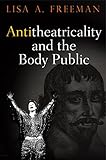Antitheatricality and the Body Public / Lisa A. Freeman.
Material type: TextSeries: Haney Foundation SeriesPublisher: Philadelphia : University of Pennsylvania Press, [2016]Copyright date: ©2017Description: 1 online resource (376 p.) : 24 illusContent type:
TextSeries: Haney Foundation SeriesPublisher: Philadelphia : University of Pennsylvania Press, [2016]Copyright date: ©2017Description: 1 online resource (376 p.) : 24 illusContent type: - 9780812248739
- 9780812293555
- Art and society -- Great Britain -- History -- Case studies
- Art and society -- United States -- History -- Case studies
- Art -- Moral and ethical aspects -- Great Britain -- History -- Case studies
- Art -- Moral and ethical aspects -- United States -- History -- Case studies
- Theater and society -- Great Britain -- History -- Case studies
- Theater and society -- United States -- History -- Case studies
- Theater -- Moral and ethical aspects -- Great Britain -- History -- Case studies
- Theater -- Moral and ethical aspects -- United States -- History -- Case studies
- Literature (Scholarly)
- LITERARY CRITICISM / Drama
- Cultural Studies
- Literature
- 792.013 23
- PN2049
- online - DeGruyter
| Item type | Current library | Call number | URL | Status | Notes | Barcode | |
|---|---|---|---|---|---|---|---|
 eBook
eBook
|
Biblioteca "Angelicum" Pont. Univ. S.Tommaso d'Aquino Nuvola online | online - DeGruyter (Browse shelf(Opens below)) | Online access | Not for loan (Accesso limitato) | Accesso per gli utenti autorizzati / Access for authorized users | (dgr)9780812293555 |
Frontmatter -- Contents -- Introduction. Antitheatricality and the Body Public -- Chapter 1. In the “Publike” Theater of William Prynne’s Histrio-Mastix -- Chapter 2. Political Allegiances and Bodies Public: Jeremy Collier’s A Short View of the Immorality and Profaneness of the English Stage -- Chapter 3. The Political Economy of Bodies Public Scotland’s Douglas Controversy -- Chapter 4. Cultivating a Christian Body Public: The Richmond Theater Fire -- Chapter 5. Adjudicating Bodies Public: in NEA v. Finley -- Notes -- Works Cited -- Index -- Acknowledgments
restricted access online access with authorization star
http://purl.org/coar/access_right/c_16ec
Situating the theater as a site of broad cultural movements and conflicts, Lisa A. Freeman asserts that antitheatrical incidents from the English Renaissance to present-day America provide us with occasions to trace major struggles over the nature and balance of power and political authority. In studies of William Prynne's Histrio-mastix (1633), Jeremy Collier's A Short View of the Immorality and Profaneness of the English Stage (1698), John Home's Douglas (1757), the burning of the theater at Richmond (1811), and the U.S. Supreme Court's decision in National Endowment for the Arts v. Finley (1998) Freeman engages in a careful examination of the political, religious, philosophical, literary, and dramatic contexts in which challenges to theatricality unfold. In so doing, she demonstrates that however differently "the public" might be defined in each epoch, what lies at the heart of antitheatrical disputes is a struggle over the character of the body politic that governs a nation and the bodies public that could be said to represent that nation.By situating antitheatrical incidents as rich and interpretable cultural performances, Freeman seeks to account fully for the significance of these particular historical conflicts. She delineates when, why, and how anxieties about representation manifest themselves, and traces the actual politics that govern such ostensibly aesthetic and moral debates even today.
Mode of access: Internet via World Wide Web.
In English.
Description based on online resource; title from PDF title page (publisher's Web site, viewed 08. Aug 2023)


